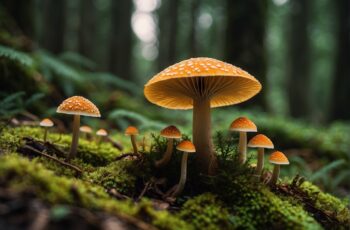Missouri, with its rivers, expansive forests, and prairies, is a forager’s paradise, particularly when it comes to mushroom hunting. The state’s natural bounty offers a diverse array of fungi, making it an exciting destination for both seasoned foragers and newcomers eager to explore the world of wild mushrooms. Knowing what to look for is key to a successful and safe foraging experience.
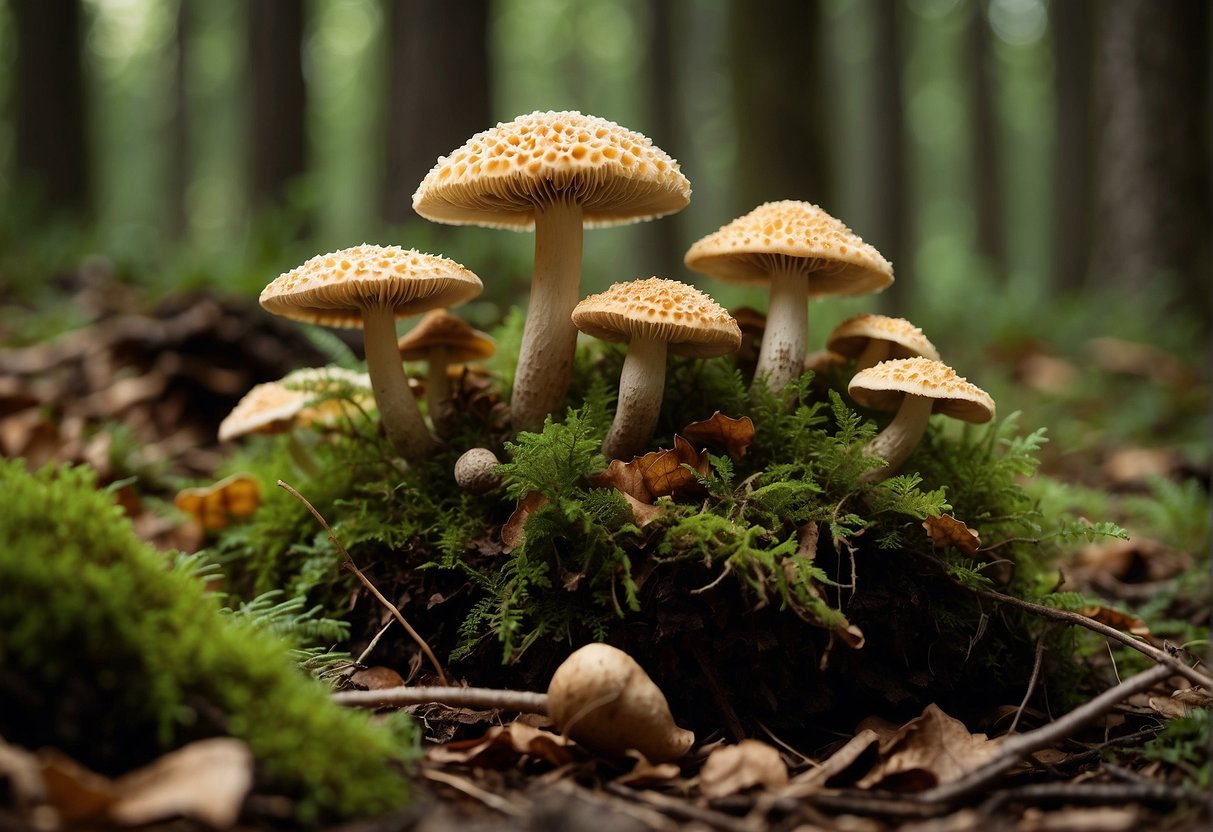
When you set out to identify and collect mushrooms in Missouri, you’re engaging in a tradition that marries outdoor adventure with the promise of delicious culinary rewards. Your guide to the most common fungi in the region will include species such as the prized morel, identifiable by its unique honeycomb appearance. Understanding the nuances of Missouri’s mushroom species is imperative, as it ensures that your foraging is both enjoyable and free from the risks associated with misidentification.
To make the most of your foraging adventures, it’s essential to have a reliable guide to help you differentiate between coveted edible mushrooms and those that could be harmful. With a careful eye and a bit of guidance, you’ll be able to navigate the forests and meadows, turning each outing into an opportunity to discover the rich tapestry of mushrooms that Missouri has to offer. Whether you’re looking to supplement your dinner table or simply enjoy the thrill of the hunt, the world of mushrooms is waiting for you beneath the canopy of the Show-Me State.
Identifying Edible Mushrooms in Missouri
When foraging mushrooms in Missouri, it’s crucial to differentiate between edible varieties and those that are potentially harmful. A solid understanding of identifying features is your key to a safe and enjoyable experience.
Morel Mushrooms
Morels are a springtime favorite with a distinctive honeycomb appearance. These prized fungi often grow near hardwood trees. The elusive morel mushroom is often the target of annual forays, and their unique spongy caps set them apart from other species.
Chanterelles
Chanterelles are recognized by their vibrant golden color and ruffled edges. You’ll find these flavorful fungi in moist woods throughout Missouri. Both the golden chanterelle and the smooth chanterelle are celebrated for their delicate, peppery flavor and potential in cooking.
Oyster and Lion’s Mane Mushrooms
- Oyster mushrooms flourish on the sides of trees and boast a smooth, oyster-shaped cap.
- Lion’s Mane, with its soft, spiny clusters, is found on hardwood trees and offers a seafood-like taste.
Other Common Edible Species
In addition to the better-known varieties, you’ll encounter mushrooms like the common puffball and shaggy mane across Missouri’s diverse habitats. Always verify with a mushroom club or the Missouri Mycological Society prior to consumption.
Foraging Best Practices
When collecting mushrooms, employ common sense. Keep the following in mind:
- Keep a guidebook handy to double-check the identity of edible species.
- Note the habitat and associated spores and color.
- Only eat what you can confidently identify.
- Consider joining a local foray with experienced foragers for practical knowledge.
Poisonous and Dangerous Mushrooms
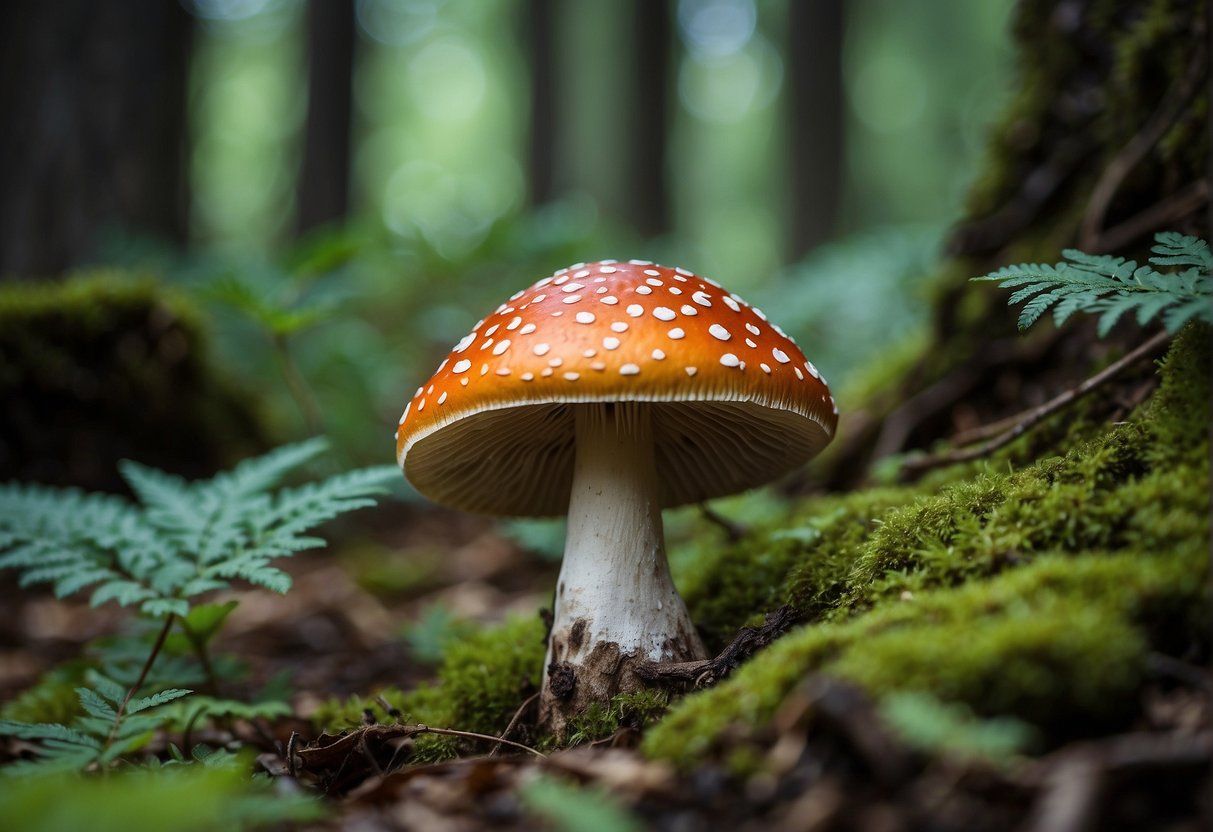
When foraging for mushrooms in Missouri, your safety depends on the ability to distinguish between edible and hazardous fungi. Some species can cause severe illness or even death, so accurate identification is crucial.
Avoiding Amanita Species
Amanita mushroom species, such as the infamous destroying angel and death cap, harbor potentially lethal toxins. These mushrooms often have white gills, a skirt around the stalk, and a basal bulb. Even a single bite can result in devastating effects such as liver failure, coma, and potentially death. Prioritize learning these species first as your guide to avoiding poisonous mushrooms in Missouri.
Recognizing False Morels
False morels are another group to be aware of given their toxic compounds that can cause serious neurological effects. While true morels are a prized edible, these dangerous look-alikes, often with a brain-like or wrinkled cap, require extra caution. If you’re uncertain, treat it as a toxic variant and do not consume it.
Other Toxic Varieties to Know
Beyond the notorious Amanita and false morel, Missouri is home to several other toxic mushroom species. It’s vital to recognize these before you set off:
- Gyromitra spp. (often mistaken for morels)
- Galernia marginata
- Lepiota spp.
These mushrooms vary in appearance but share one thing: a risk to your health. While some might not be deadly, consuming them can still lead to unpleasant symptoms requiring medical attention. To protect yourself, always seek a positive identification and when in doubt, leave the mushroom where you found it.
Mushroom Biology and Ecology
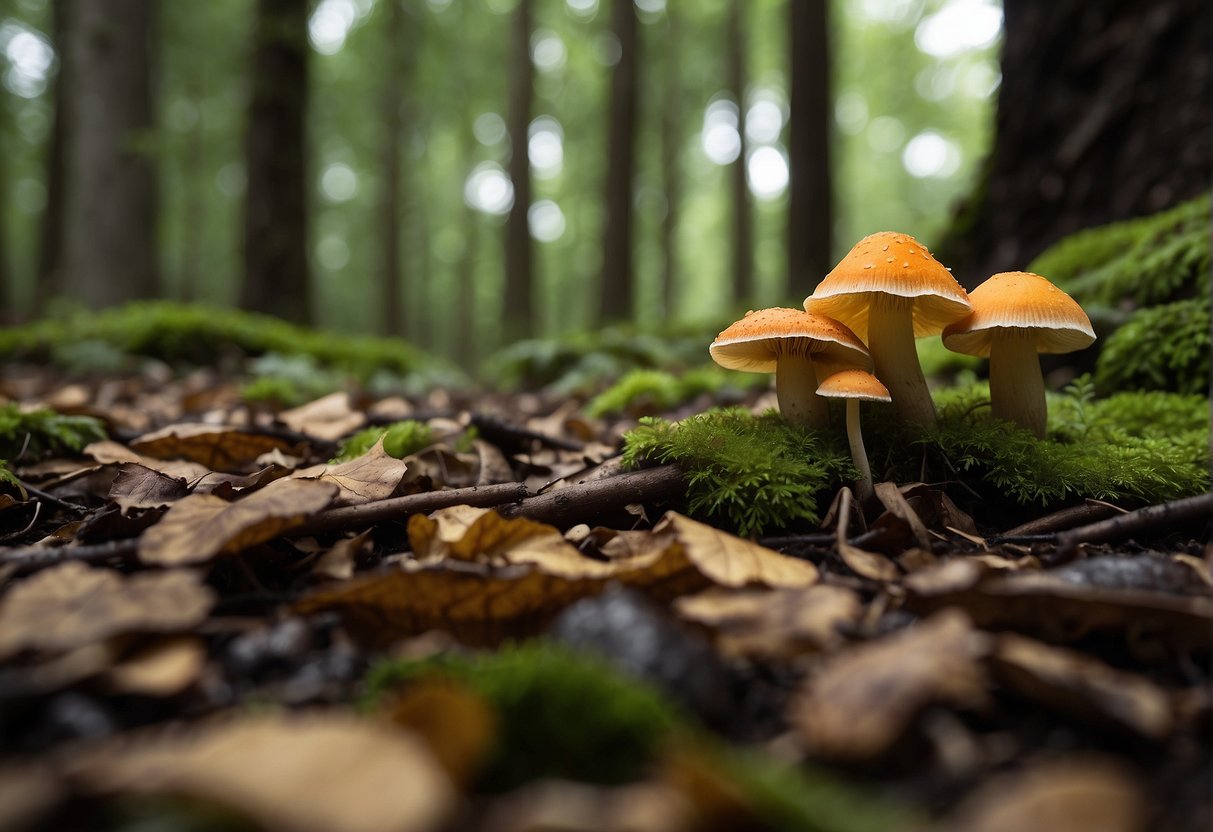
Mushrooms are more than the cap and stem you see; their biology and their roles within the ecosystem are intricate and vital. Let’s peel back the layers of these fascinating fungi.
Understanding Mushroom Anatomy
Mushrooms are the fruiting bodies of fungi, specifically designed for reproduction. As an outdoors enthusiast, you’ll find that knowing about mushroom anatomy can assist in identifying species and even determining edibility. The parts of a mushroom you’re probably familiar with include the cap, stem, and gills. Beneath the surface, an extensive network called mycelium spreads out, akin to roots in a plant.
Here’s a quick rundown of the key parts:
- Cap (Pileus): Often shaped like an umbrella, this is the top part of the mushroom where spores are produced.
- Gills: Located underneath the cap, gills release spores into the environment.
- Stem (Stipe): The main support of the mushroom, elevating the cap to help disperse spores.
To identify mushrooms in the wild, you might take a spore print. This involves removing the stem, placing the cap gill-side-down on paper, and waiting for spores to fall out, leaving a powdery imprint. The color of this print can help you differentiate between mushroom species.
Habitats and Ecosystem Roles
Missouri’s forests, prairies, and state parks are natural havens for a variety of mushrooms. You may find polypore mushrooms growing on the sides of hardwood trees, while puffballs might sprout on the forest floor. The habitat of a mushroom influences its form, with some preferring the decaying wood of forests and others, like grassland-loving fairy rings, thriving in open prairie landscapes.
Mushrooms function as nature’s recyclers. They break down organic material, returning nutrients to the soil, and maintaining the health of the ecosystem. Some edible mushrooms you might find in Missouri include morels, which favor areas disturbed by fire, and chanterelles, preferring the shade of hardwood trees.
When out foraging or exploring, remember fungi play an essential role, and your knowledge of their biology and ecology can enrich your appreciation for these complex organisms.
Legal Considerations and Ethical Foraging
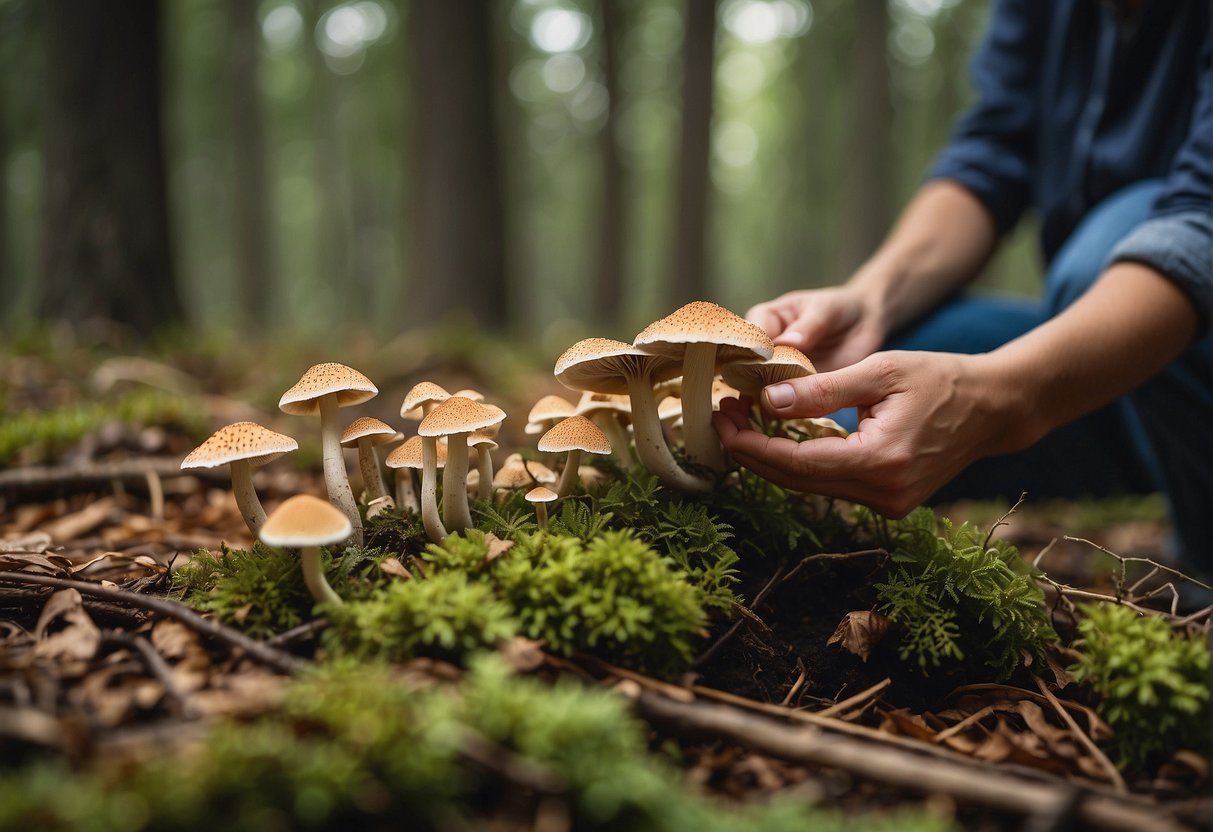
Before you set off on your mushroom hunting adventures in Missouri, it’s critical to note that certain laws and responsible foraging practices should guide your activities. Not only are these measures in place to protect you and the environment, but they also ensure the continuity of mushroom populations for years to come.
State Regulations and Permissions
Missouri provides a variety of habitats for mushroom foraging, yet it’s imperative to understand the state regulations governing this activity. You must confirm whether the land you wish to forage on requires a permit, especially in state parks where special rules may apply. The Missouri Department of Conservation’s guide to Missouri’s mushrooms is an excellent resource for staying on the right side of the law.
Sustainable Harvesting Practices
When you venture into the woods, let sustainable practices be your guide. Take care to harvest only what you’ll use, and pick in a manner that allows the fungi to continue thriving. This means cutting mushrooms at the stem rather than pulling them out, which can harm the mycelium beneath the soil.
Engaging with Mycological Societies
Connecting with a mushroom club or the Missouri Mycological Society can be invaluable. Such societies offer a wealth of knowledge and can provide insights into local foraging practices, conservation efforts, and support for both novice and experienced foragers.
Using Field Guides and Resources
Enhance your identifying skills by consulting multiple field guides and cross-referencing the mushrooms you encounter. A trusted field guide will not only assist you in safely identifying edible mushrooms but also alert you to those that are toxic. Digital resources and local mycologist recommendations can also be of great use.
Culinary Applications and Recipes
Once you’ve applied common sense and foraged wisely, you can explore the culinary applications of your find. Edible mushrooms in Missouri offer a burst of flavor that can transform any dish. Use reliable sources for cooking and check out recipes that highlight the unique characteristics of your foraged mushrooms. Remember, if uncertain about the edibility of a find, it’s safer to simply enjoy its natural beauty rather than risk its consumption.


